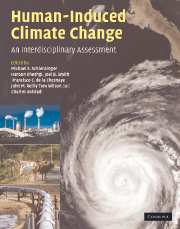Part III - Mitigation of greenhouse gases
Published online by Cambridge University Press: 06 December 2010
Summary
Introduction
An important component of integrated assessment models is an evaluation of the costs and technology implications of mitigating greenhouse gases. Many existing Integrated Assessment (IA) models started as global energy models that were first turned towards examination of the cost and technology implications of reducing CO2 emissions. Further representations of Earth system processes were later added to describe the impacts of policies on atmospheric concentrations of greenhouse gases and on changes in climate and its economic effects. For those IA models with an energy model heritage, the implications of greenhouse gas mitigation for the economy, energy use, and energy technology remains a relative strength. Developments in modeling energy–economy interactions quite apart from the broader goals of IA have continued. The demands of IA have meant that the energy model components have had to expand to cover additional anthropogenic activities that contribute to climate change and the mitigation opportunities associated with them. Papers in this section address recent advances in this regard.
The topics addressed here can be broadly grouped in the following areas: first, better characterization of the technological opportunities for reducing greenhouse gases; second, broadening the scope of the models to consider non-CO2 greenhouse gases and also to consider land-use change and carbon sequestration in vegetation and soils; and third, better characterization of the impact of climate policy on the economy.
- Type
- Chapter
- Information
- Human-Induced Climate ChangeAn Interdisciplinary Assessment, pp. 167 - 170Publisher: Cambridge University PressPrint publication year: 2007
- 1
- Cited by



